The Art of Music-Making on a 2-String Cigar Box Guitar
If you are reading this blog post, you likely already own a cigar box guitar or are considering buying one. But have you ever played a two-string before? I admit I wasn’t thrilled with the idea of playing a two-stringer as it would be too limited with chords and range, but surprisingly, I was amazed at how fun and liberating it was.
Unveiling the Power of Simplicity
Before we continue our 2-string journey, as mentioned, there are definite limitations with only two strings! Playing single-note melodies works fine, but getting a full-sounding chord is limited. Most chords, such as triads, require three notes, so the best we can do is omit one of the triad’s notes to approximate the quality of the chord.
Also, you will need to move your hand around more to reach notes due to the limited range of two strings. I experimented with several tunings but ended up with G on the bigger 2nd string and D on the first string. I also was successful with the perfect fourth tuning G (2nd) and C (1st). This second G-C tuning has an advantage if you are already a guitar player, as the guitar is also tuned in perfect fourths, excluding the second string (B) on the guitar.
In this lesson, we will learn how to play and set up your 2-string cigar box guitar, then move on to learn some chords, the fingerboard notes, scales, and a few arrangements, all from my book Cigar Box Guitar: The Ultimate 2-String Collection.
First, let’s learn how to set up and play your two-string CBG.
Setting Up Your Cigar Box Guitar
The first question would be: is your CBG set up to be played with a slide with a higher action (the distance of strings to the neck), or does it have a lower action and played with the fingers? Most CBGs are set up to work with a slide and fingers, but if you are a slide-only player, you may consider raising your action a little to avoid string rattle with the frets.
One note about a higher action: the slide can go out of tune when fingering or pressing notes or chords on the fingerboard. Set the intonation so the notes and chords remain in tune when you press down on the strings. The string gauges range in diameter, but I typically use a .042″ and .030″ gauge.
Higher action = good for slide.
Lower action = better tuning.
Fingers or Picks?
There are no right or wrong ways to play your CBG, but learning to play with your fingers will give you more options. Of course, you can always switch between fingers and pick. You might also consider thumb and steel finger picks on your index and middle finger. Experiment to see what works best for you and compliments your music style.
Here’s a pic of my typical playing technique with the thumb on the second string and my index and middle alternating on the first string:

The Slide
Finding the correct slide is a challenge of its own! For many years, slide players would have to conform to commercial slides that are often too big or narrow. Fortunately, more slide manufacturers now cater to different finger sizes and materials (glass, metal, ceramic, bone).
Try different slide materials to find the tone you like best. Some players prefer a raspy, sharp sound with a steel slide, while others like a round, smooth sound with glass. Of course, the slide you choose will also depend on which finger you wear the slide. Most players put the slide on the 3rd or 4th finger, allowing the other fingers to play simultaneously. There are no rules, so try the slide on different fingers and do what feels natural.
An example of playing with a 2″ glass slide on my third finger:

Finger Positions
Most of the pieces in my book show the fingering for the left hand in the notation line. You will see a small number beside a note to indicate a suggested fingering. There are often alternate ways to finger a piece of music, so always look ahead to where your fingers need to be and work backward to find the most efficient way to produce a clear sound. This is especially true when you only have two strings.
Let’s learn about the fingerboard and how to play some chords.
The Two-String Cigar Box Guitar Fingerboard (G-D)
If you tune to G and D, your two notes are a perfect fifth apart. This means if you count from G to D (G-A-B-C-D), the interval distance is five notes. If you make a barre with your finger and play both strings, you are technically playing a 5th or “power chord.” This power chord can be either major or minor, as the important third note is missing. In other words, you can play two chords with one fingering.

2-String Cigar Box Guitar Chords
Of course, there are limitations as you will want to add the third note to define either major or minor. To do that, we have to learn our major and minor chords. As mentioned earlier, we must omit one of the notes from the note triad. Let your ear be the judge of what voicings sound best to you. Here are the major and minor shapes with A as the root note:

Practice those chords until you can play them clearly, and try to switch between them. Next, we will learn a simple song and a few familiar chord progressions to help us remember the chord shapes.
Are you interested in the 3 and 4-string Cigar Box Guitar? Check out this post:
Learn how to play cigar box guitar | Kalymi Music Blogs (brentrobitaille.com)
Two-String Chord Progressions
Many popular songs use repeating chord progressions with three or four chords, so here are a few familiar chord progressions to work on. You can use a simple down/up strumming or choose one of your own patterns.
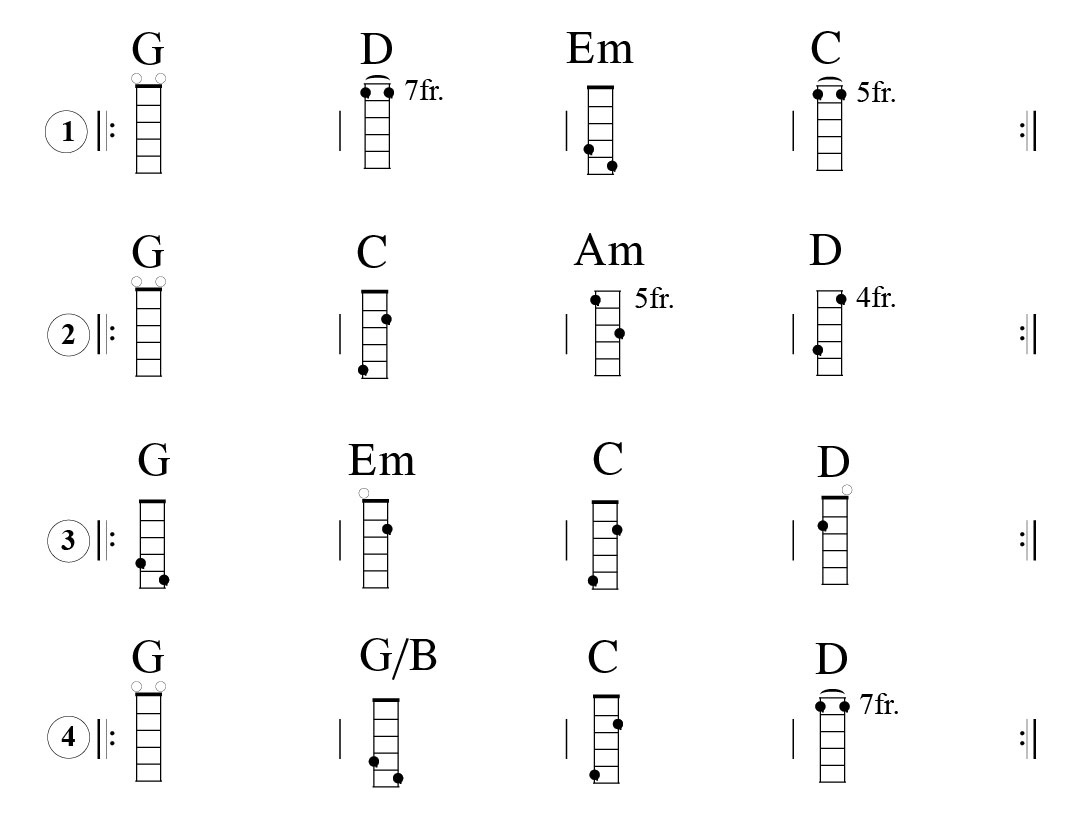
The next step is to convert some of the songs you already do on your guitar or 3-string cigar box over to the two-string. You must often be creative in choosing the best-sounding chord voicing with only two strings, so experiment with the chord inversions until you find a chord progression with good voice leading.
What is Voice Leading?
Definition: the smooth and logical progression of individual melodic lines or voices within a musical composition, emphasizing the importance of minimizing leaps and creating coherent and expressive harmonic connections.
In other words, get the chords to connect without moving your hand too much. Also, the note on the first string is a higher pitch and, therefore, has a melodic component to it when switching chords. So, think in terms of melody with the first string note. Ask yourself, do the notes connect melodically and smoothly on the first string? This is a real challenge with only two strings!
We will continue our two-string journey and learn a chord melody (combining melody and chords) of a well-known tune. Here’s the audio track, the sheet music with tablature and the video:
Scarborough Fair on Cigar Box Guitar
“Scarborough Fair” is a traditional English ballad with a long and varied history. The song’s origins are unclear and has undergone numerous adaptations and interpretations over the centuries. The version most widely known today is often associated with the 1960s folk music revival, notably Simon & Garfunkel’s rendition.
This chord melody arrangement is an excellent example of what can be done with two strings. The melody is clear, although it requires some jumps up and down the neck. Use lots of slides and ornament the melody with hammer-ons and pull-offs. Notice the suggested finger markings in the notation line and watch the video or listen to the audio track below:
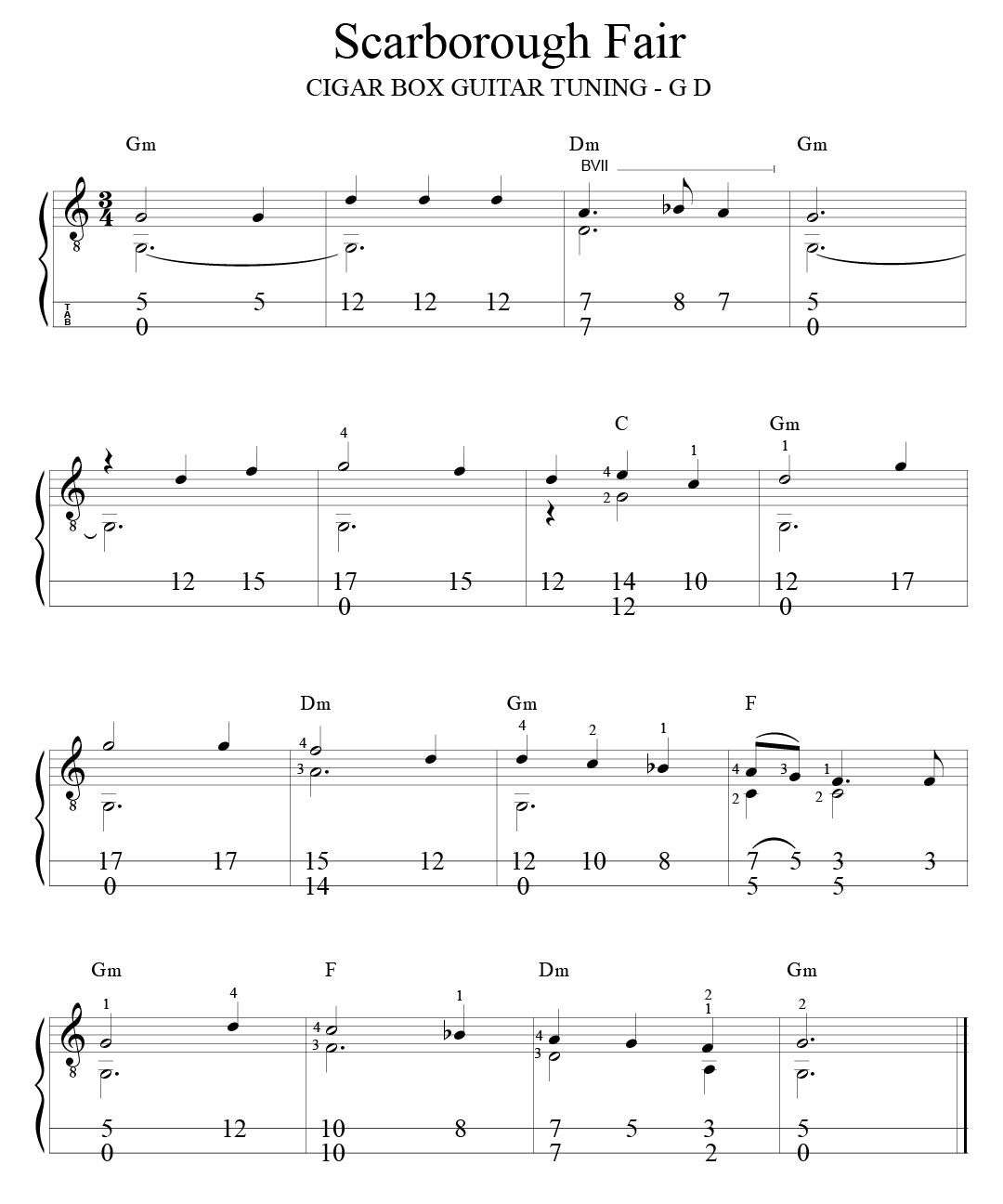
Before we finish our first two-string cigar box guitar lesson, we will look at the blues and how to improve your playing technique.
Blues Riffs on the 2-String Cigar Box Guitar
I can’t imagine playing the cigar box guitar without mentioning the blues. It doesn’t matter how many strings you have; jamming the blues is possible on any instrument. Playing in G is undoubtedly the most approachable with the open G tuning, but any key is possible. Try a few of the riffs below to get started. Listen to the audio for the riffs on Soundcloud. For more riffs and blues progressions, check out the book.
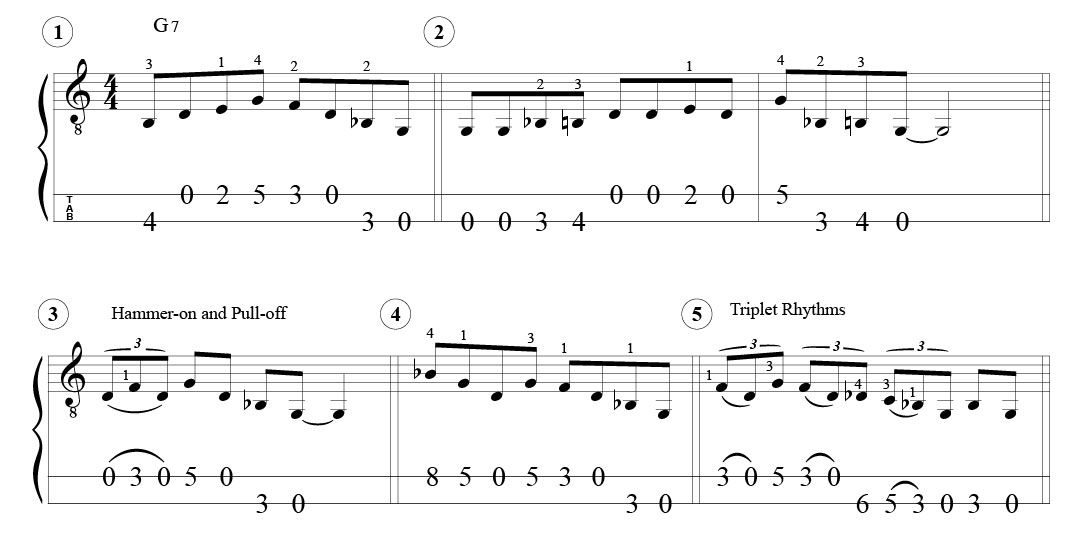
CBG Technique
Learning any instrument requires hours and years of practice, and scales, arpeggios, finger exercises, etc., should be part of it. Read my 25 practice tips if you need structure for your practice time.
The book has several good finger exercises, but I like the arpeggio practice best. The scales are also excellent for learning position playing and stretching your fingers. Remember to keep the finger close to the fret to avoid buzzing. Play all exercises slowly and aim for accuracy.

Final Thoughts on Your Two-String Cigar Box Guitar Journey
As we conclude this exploration of the 2-string Cigar Box Guitar, it’s evident that limitations can be opportunities for creativity and musical innovation. Embracing the unique challenges of playing with only two strings opens doors to new sounds and techniques. Whether you choose to slide, fingerpick, or strum, the world of the 2-string CBG beckons with possibilities. So, tune in, play on, and let the two strings guide you on a musical adventure like no other.
I hope you have enjoyed this introduction to the 2-stringer. For more cigar box guitar lessons go here. Feel free to leave comments or suggestions for future lessons and books below. Good luck! Brent
Two-String Cigar Box Guitar Ultimate Collection
“Unlock the unique world of the 2-String Cigar Box Guitar (CBG) with this comprehensive guide that takes you on a musical journey from beginner to advanced levels. Now Available at Amazon and Other Online Bookstores.
The Complete Cigar Box Guitar Chord Book
The Complete Cigar Box Guitar Chord Book is the most extensive library of chords ever assembled for the 3-string cigar box guitar. With over 2000 chords, chord progressions, strumming patterns and exercises included. Chords are shown with diagrams, tablature, notation, and some photos. A must-have for all cigar box guitar players.
3-String Cigar Box Guitar Chords in GDG Tuning
Cigar Box Guitar – Blues Overload
Master the blues. Everything you need to learn the blues on the 3 String Cigar Box Guitar (GDG). A complete method with over 330 pages! Including blues tunes, riffs, chord progressions, blues scales and much more. A must have for all cigar box guitar players. Audio tracks below.
Complete Blues Method for 3 String Cigar Box Guitar
3-String Cigar Box Guitar Chord and Fretboard Poster Set
- Elegant 3-string cigar box guitar chord and fretboard poster set.
- Two posters included – 3 string cigar box guitar chords and fretboards tuned GDG.
- 2-page chord and fretboard music theory insert also included (letter size).
- Convenient size poster 12” x 18”. Side by side, the two posters are 24” x 18”.
- All posters have a gloss finished printed on 100# Digital Gloss Text.
[yop_poll id=”5″]
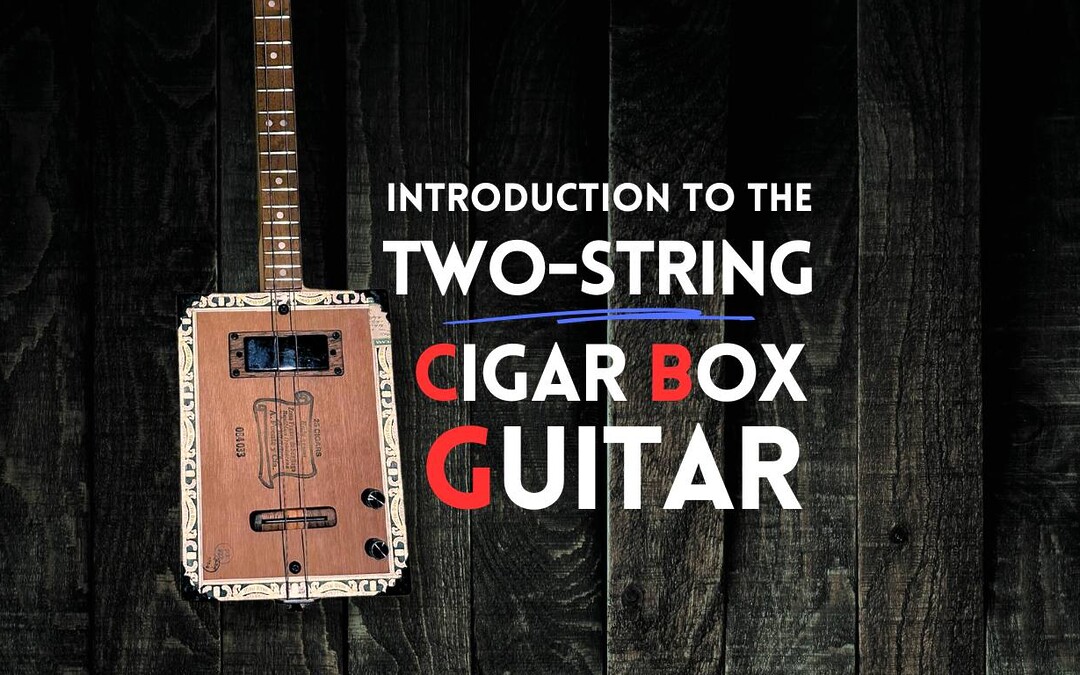
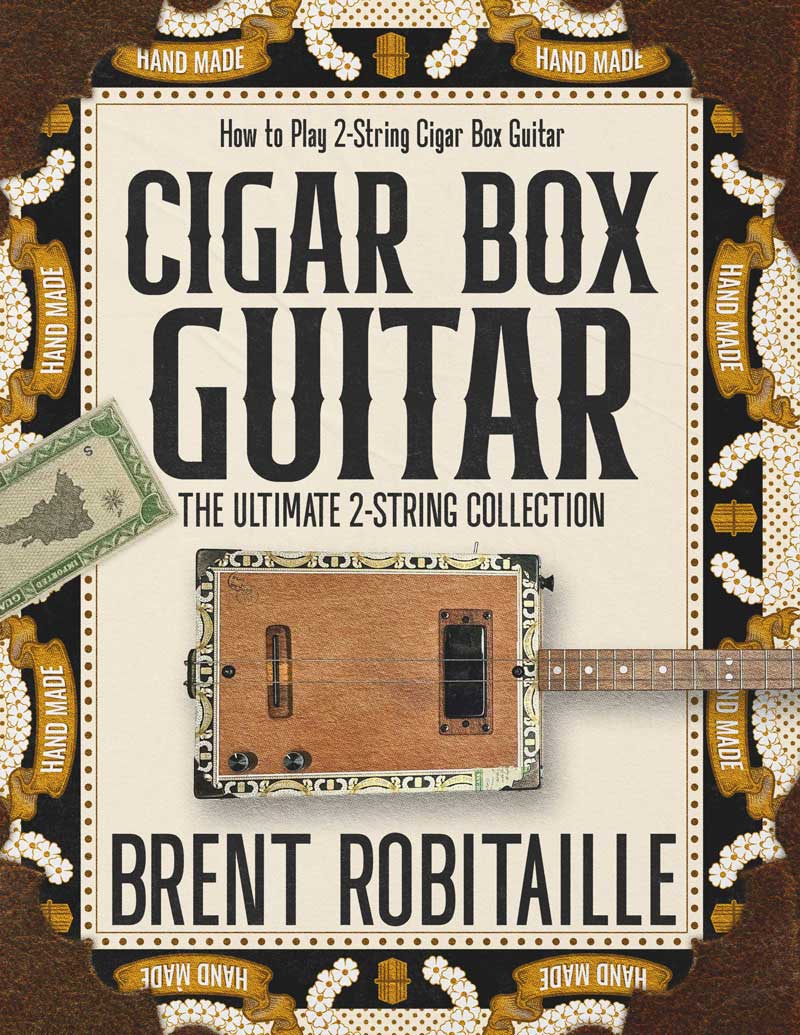

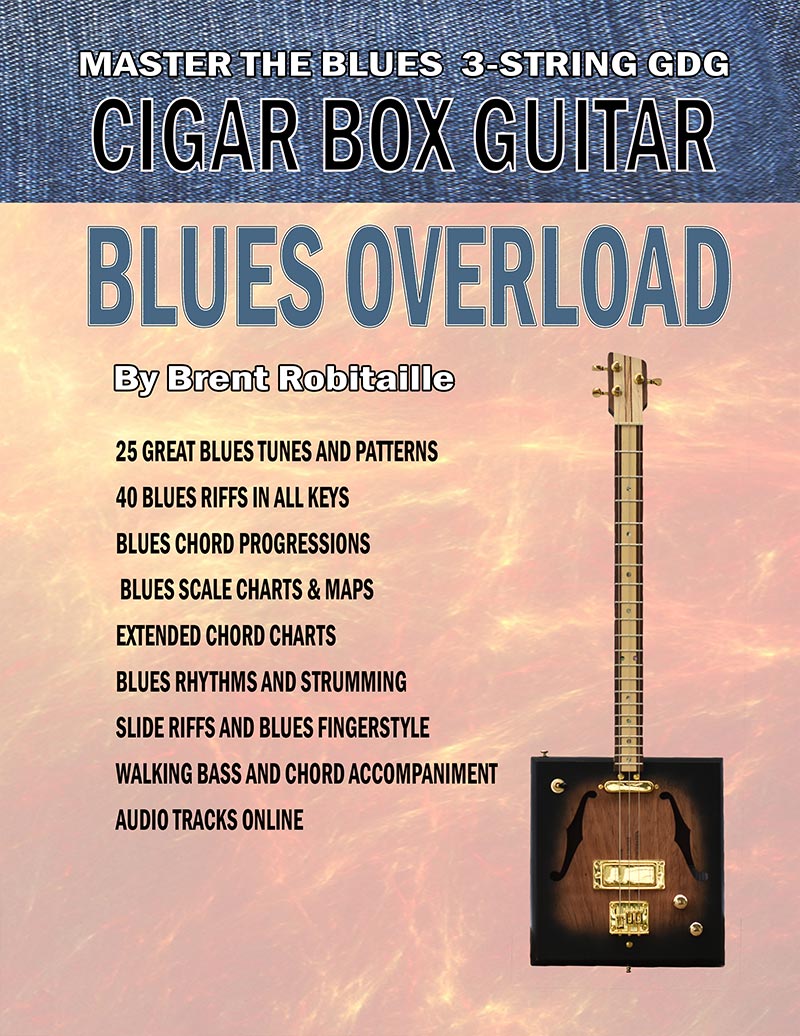
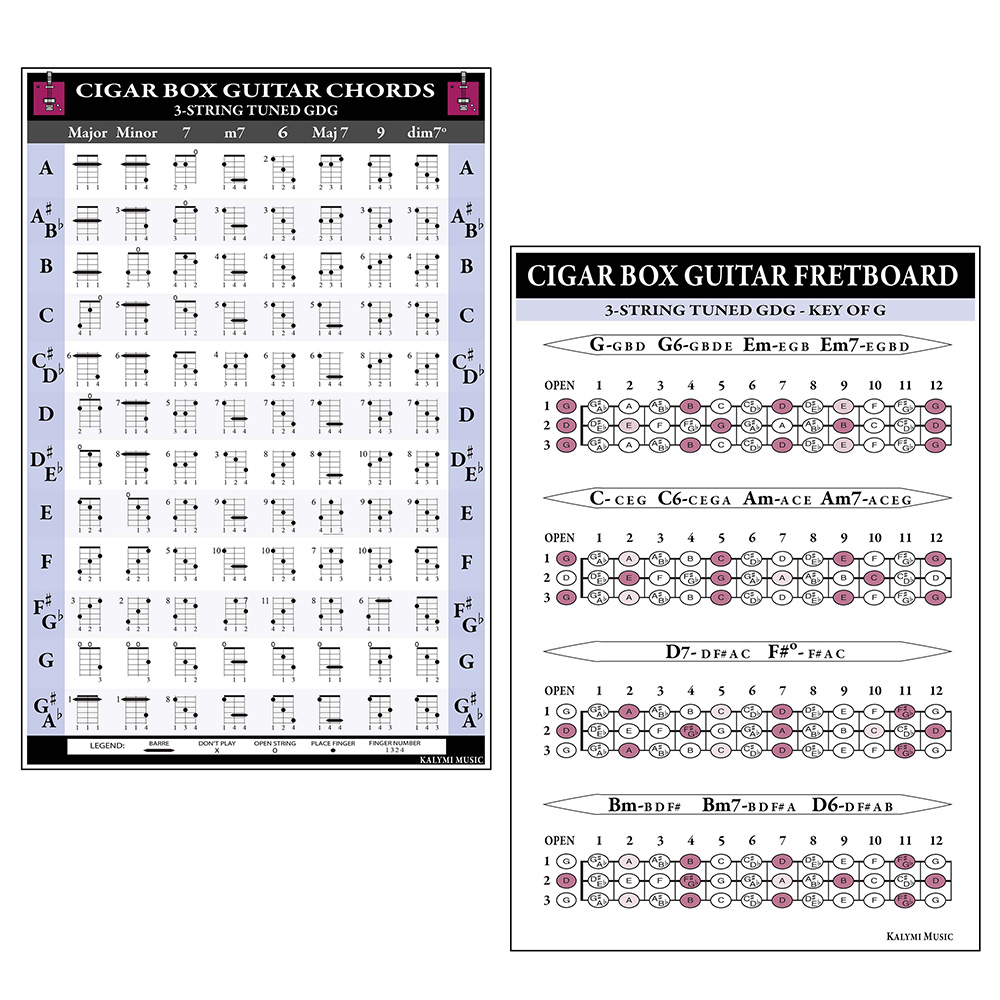
A chord chart for a 2 stringed cbg if there is one. So fR I’ve built a diddlybow and 3 stringed cbg. Next I want to do a 2 stringer. Lastly I’ll do a 4 stringer tuned like a tenor guitar.
Hey, that’s great you are building CBGs. I don’t have a 2-string poster but there is a good selection of chords in the book with practice chord progressions and blues. Here’s a link:
https://brentrobitaille.com/product/two-string-cigar-box-guitar-ultimate-collection/
Thanks for commenting.